
Synthetic Fiber Ropes for Forestry Use
Fiber ropes for forestry use are offered by several manufacturers. According to studies, fiber ropes offer a wide range of advantages in comparison to steel wire ropes: For example: the low weight of fiber ropes facilitates forest operations and serious accidents through broken wires are avoided.
The difference in prices and types of those ropes which are currently available on the market is astonishing. A series of studies concentrating on the practical use of ropes aim at investigating how the individual products differ in terms of handling and durability.
For investment decisions, it is very important to look at the durability of the material in the light of the great price difference.
Planning and organisation of test sections requires comparability and repeatability of the ropes. Also compression tests are of needed in order to be able to draw conclusions on the utility of the ropes.
Tests are carried out in three stages
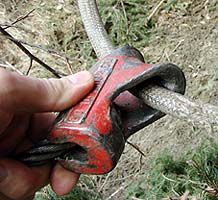
Ropes submitted to heavy stress through choker gliders
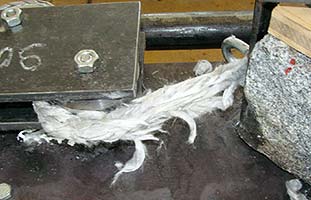
Ropes submitted to heavy stress through choker gliders
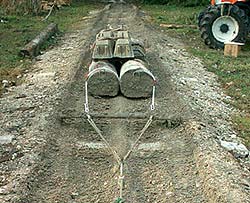
Testing for abrasion resistance
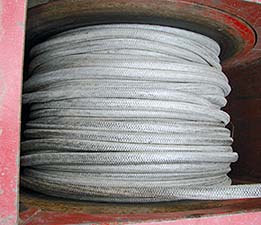
Fiber rope
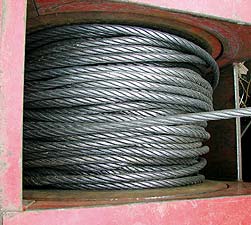
Fiber rope
1. The “Choker gliding test” (longitudinal abrasion and bending strength)
The strongest stress factor for a rope can be expected in the moving section of the choker glider. Gliders developed for use with steel wire ropes are suitable to a limited extent. Square edges and redirection over small bending radii are particularly bad for the rope. A few manufacturers try to meet this special requirement by constructing special gliding systems, though without much success. Gliders which adjusted to the low weight of the rope and required for ergonomic reasons are not yet available.
A series of tests was carried out on a specially designed device, by means of which the testing rope with defined pre-tension and pre-adjusted deflection is pulled over rollers and frictional resistances. These tests have revealed that only the use of genuine choker gliders can bring good results suitable for practical application. In this process, it is tested how some glider types react with different types of ropes.
Damages will be visible after a number of repetitions. They suggest the replacement state of wear as well as the residual breaking strength and will give information about the quality of the material.
2. Ground pull-test (longitudinal abrasion under field conditions)
The abrasion resistance of ropes when pulled along rough ground is the most crucial criteria for the possible duration of usage until falling below the value of the required minimum break force (twofold pulling force in a winch wire) and the necessary rope selection. The choker gliders are submitted to heavy stress during the last meter. According to our experience, abrasion takes place only at one third of the used rope length.
Testing for abrasion resistance resulting from pulling along rough ground is carried out on an uneven surface. Unevenness is reached by applying a mixture of crushed stone and earth.
Concrete sleepers arranged at right angles to the slideway keep the slideway from sinking deeper into the soil on the one hand and increase the rope damaging effect by the crushed stone on the other hand. For this test, the rope will be tied under specially designed wooden skids with defined weight. Then, it will be pulled over the ground by changing the direction side to side.
The numbers of repetitions carried out until any damages are visible induce the replacement state of wear and the remaining tensile strength will allow conclusions concerning the durability of the respective ropes.
3. Winding performance
Basically, the winding performance of fiber ropes is excellent compared to that of steel wire cables. Practical experience has shown that the winding performance – independently from the winch type – is not a criterion for durability.
It is crucial that all square edges and spines along the whole guideway of the rope be removed at the winch. It could not be confirmed that the design of the drum and the feeding angle of the rope has an impact on the durability of fiber ropes as is the case for steel wire cables.
Criteria for the replacement of fiber ropes
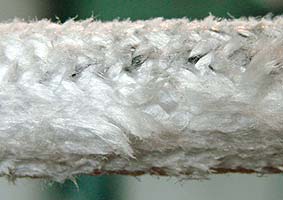
Shortcomings in the cover – core protection still intact

Shortcomings in the cover – core protection still intact
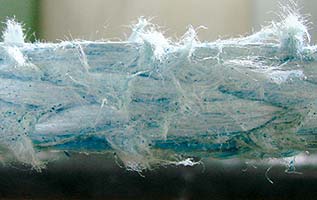
Clear symptoms of wear – breaking load?
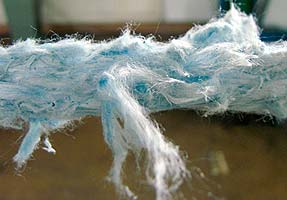
Clear symptoms of wear – breaking load?
When shall a rope be replaced?
For security reasons and to protect individuals who work with this type of ropes, clear decision-making aids are needed in order to be able to assess the usability and replacement state of wear of a rope as applies to steel cables. The test series planned by BFW can provide a first answer to this question.
In case of ropes with cover/core construction the condition of the cover provides clear indications on the replacement state of wear. Provided that the core has not been damaged by heat, pinch or other influences, the full tensile strength will theoretically be maintained as long as the protection function of the cover is assured.
In open rope constructions without cover the replacement state of wear cannot be clearly stated from the outer appearance only. For the inspection guidelines from the nautical sector are available. They recommend to sort out ropes when showing a material loss of individual strand lacings of 25 % at maximum.
The identification of these criteria is difficult and the remaining breaking load is not clear. In order to improve the situation one task of the above mentioned research will be to elaborate an easy to handle criteria catalogue.
Security hints for the use of fiber ropes
|
